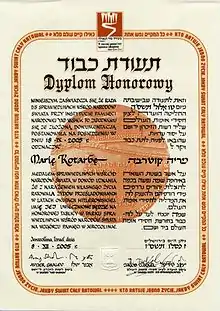Petronėlė Lastienė
Petronėlė Lastienė née Sirutytė (9 September 1897 – 30 November 1981) was a Lithuanian teacher and university professor. She was recognized as one of the Righteous Among the Nations for rescuing Jewish people from the Kaunas Ghetto during the Holocaust.[1][2]
Lastienė was born in Dalginė (Marijampolė Municipality) of the Suwałki Governorate.[2] She was a childhood friend with Ona Matulaitytė, the future wife of Aleksandras Stulginskis.[3] In 1914, she graduated from the Russian-language Girl's Gymnasium in Marijampolė and went on to complete nursing courses. From July 1915 to September 1916, she was a nurse with the 10th Army in the present-day Belarus. In Moscow, she completed four semesters at the history and philology section of the Poltoratskaya's Higher Courses for Women (Russian: Высшие женские курсы В.А.Полторацкой). In 1918, she returned to Lithuania and became a teacher of history, geography, and Russian language in Marijampolė.[2] She married poet Adomas Lastas.[3] In 1923, she moved to Kaunas where she taught at a gymnasium for adults while studying at the Faculty of Humanities of the University of Kaunas. From 1929 to 1940, she was an editor of Vadovė journal for girl scout leaders. In 1938, she became teacher of history at the Kaunas 5th Gymnasium where she was promoted to headmistress after the Soviet occupation of Lithuania.[2] During the Nazi occupation of Lithuania, Lastienė hid several Jews, including her former student Tamara Lazerson, from Nazi persecution.[1] Yad Vashem recognized her as one of the Righteous Among the Nations in 2000.[4]
After the return of the Soviet regime in mid-1944, Lastienė briefly taught at the University of Kaunas and organized courses for workers and farmers.[2] Together with Tadas Petkevičius and three others, she authored a memorandum addressed to Western powers on the Soviet occupation and worked with Petras Klimas to have it translated to French and smuggled abroad.[5] For this, she was arrested in autumn 1945, convicted of counter-revolutionary activities, and sentenced to eight years in Gulag and five years in forced settlements.[2] She was sent to the Uhtizhemlag in the Komi ASSR where she worked as a nurse at the camp's hospital. She returned to Lithuania in 1953, after the death of Joseph Stalin. As a former political prisoner, she faced difficulties in finding employment, but her former student now rector of Kaunas Polytechnic Institute Kazimieras Baršauskas managed to get permission from First Secretary Antanas Sniečkus to employ her as a professor. She was prohibited from teaching history and instead taught the Russian language. She worked at the institute from autumn 1955 to retirement in 1963.[2] Vilnius University Library stores a personal collection of her documents (Fond 161).[6]
Lastienė also translated and published several fiction works: the play Inno del primo maggio by Pietro Gori (1920), the comedy The Wood Demon by Anton Chekhov (1921), the play Autumn Violin by Ilya Surguchov (1922), and the novel Nomads of the North by James Oliver Curwood (1937). She also translated two history textbooks, History of the Middle Ages (1923) and History of the Modern Ages (1925) by Robert Wipper.[2]
References
- "Lastienė FAMILY". The Righteous Among The Nations. Yad Vashem. Retrieved 10 June 2017.
- Tamašauskas, Albinas. "Lastienė Petronėlė". KTU veteranų klubas „Emeritus“ (in Lithuanian). Kaunas University of Technology. Retrieved 10 June 2017.
- Eidintas, Alfonsas (2001). President of Lithuania: Prisoner of the Gulag: a Biography of Aleksandras Stulginskis. Translated by Thomas A. Michalski. Genocide and Resistance Research Center of Lithuania. pp. 38, 296. ISBN 9986-757-41-X.
- "Lastienė Petronėlė (1897 - 1981)". The Righteous Among The Nations. Yad Vashem. Retrieved 10 June 2017.
- Ašmenskas, Viktoras (2009). Didžiosios tautos aukos (PDF) (in Lithuanian) (3rd ed.). Diemedžio leidykla. p. 150. ISBN 978-9986-23-155-4.
- "Inventory list of collections". Vilnius University Library. Retrieved 10 June 2017.
